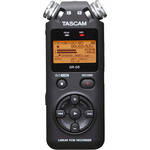In 2010, RODE introduced their Original Video VideoMic Pro, a cold shoe mount small shotgun microphone. According to today's press release, this is their best selling microphone. That's interesting, I would have expected the NT1A large diaphragm condenser to be their best seller among the beginning home music recording crowd.
One problem with the original Video Mic Pro was the isolation mounting. It essentially used rubber bands that worked decently, but had a tendency to fall off or break over time. And, they weren't the best at isolating the mic from camera or boom movement.
Earlier today, RODE announced an updated version of the VideoMic Pro with Rycote Lyre with two new headline features: a redesigned capsule, and a new Rycote suspension system.
Now those of you that know me, know that I'm not a huge fan of mounting a shotgun mic on top of my camera. That technique has its place, but I rarely do it because it doesn't sound all that great for two reasons: 1) it is usually too far from the talent and 2) it also picks up whatever happens to be behind the talent (and that can include audio reflections off a wall if that's what is behind the talent).
However, like I said, there are cases when you don't have any other choice. When I met up with Dave Dugdale at NAB this year, I saw that he was shooting with his Video Mic Pro on his Sony A7s. Totally get it. He didn't have a lot of other options since he was trying to stay light for a full day of walking around the show floor and the audio quality expected from this setup was good enough for what he was doing. Totally legitimate.
However, in cases where you're shooting at a location where it would be practical, I like to take that mic off the camera and boom it over the talent. This solves both problems: The mic is now much closer (within 40 - 60cm of the talent) and it is pointed down so it only captures the talent and not everything behind them. I showed this in one of my older episodes and will do it again in one of my upcoming episodes.
In that light, RODE was kind enough to send me an evaluation copy of the new Video Mic Pro a while back so that I could evaluation it. Frankly, I've only spent a few minutes with it so far because I've been busy working with the RODELink system, but I'm hoping to have a closer look at it in the next few weeks here.
The new mic is just a tiny bit larger than the original and the foam windscreen is larger so the original dead cat furry cover won't work with the new mic. But I would hazard a guess that RODE will have a new version of the dead cat available before too long.
Let me know if there are any specific questions you'd like answered about this mic and we'll be sure to cover that in the episode.


